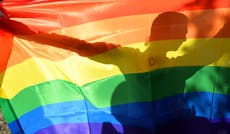The Independent's journalism is supported by our readers. When you purchase through links on our site, we may earn commission.
What do all the letters in LGBTQIA+ stand for?
LGBT initials were first used in the 1990s
Your support helps us to tell the story
From reproductive rights to climate change to Big Tech, The Independent is on the ground when the story is developing. Whether it's investigating the financials of Elon Musk's pro-Trump PAC or producing our latest documentary, 'The A Word', which shines a light on the American women fighting for reproductive rights, we know how important it is to parse out the facts from the messaging.
At such a critical moment in US history, we need reporters on the ground. Your donation allows us to keep sending journalists to speak to both sides of the story.
The Independent is trusted by Americans across the entire political spectrum. And unlike many other quality news outlets, we choose not to lock Americans out of our reporting and analysis with paywalls. We believe quality journalism should be available to everyone, paid for by those who can afford it.
Your support makes all the difference.In October, people in the US will observe LGBT+ history month, a period during which we reflect on and celebrate the history and achievements of lesbian, gay, bisexual and transgender people.
The month-long period of observance, which is different than Pride Month in June, was created in 1994 by Missouri high school history teacher Rodney Wilson, the first openly gay public school teacher in the state. Wilson chose October because the first and second LGBT Marches on Washington, in 1979 and 1987, took place during the month.
It was also during the mid-to-late 1980s that the language used to refer to the gay community changed, according to PinkNews, as the acronym LGB was first introduced, to refer to those who were lesbians, gay or bisexual. By the 1990s, the acronym was updated to include the letter “T,” which refers to those who are transgender.
As awareness around the LGBT+ community has grown, so have the words used to describe different sexualities - with the language surrounding the spectrum of sexuality constantly evolving.
In recent years, the queer community has most commonly been referred to as the LGBT or LGBTQ community.
The acronym is also seen with a + sign at the end, which has its own significance.
Although not everyone in the queer community chooses to subscribe to specific labels, this is the most commonly used list of terms to refer to non-hetero sexualities.
LGBT is an initialism for lesbian, gay, bisexual and transgender. The acronym, which is often used as a blanket term to refer to the queer community, first became popular in the 1980s when it replaced the term gay to reference all those who do not identify as heterosexual.
It has since grown to LGBTTQQIAAP, to encompass numerous other sexual and gender identities.
What do the additional letters mean?
As understanding about sexuality and sexual identity has grown, a fifth letter has been added to the acronym with increasing frequency.
The Q often placed at the end of LGBT refers to queer or questioning, according to the Lesbian, Gay, Bisexual and Transgender Community Center.
Previously, Cleo Anderson, an employee of the LGBT rights group GLAAD told USAToday: “Queer is anything that exists outside of the dominant narrative. Queer means that you are one of those letters [LGBT], but you could be all of those letters and not knowing is okay.”
Anderson also said the Q is useful because it “can be used to convey the nuances of race and culture and how that intersects with an individual’s gender identity and sexual orientation”.
The acronym has also expanded to include an I and an A at the end, making it LGBTQIA.
According to the LGBT youth support group OK2BME, the I stands for intersex.
Intersex is an umbrella term “that describes bodies that fall outside the strict male/female binary”, according to Planned Parenthood.
The A on the end of the acronym also has multiple meanings, used to represent those who identify as asexual, those who are agender, and those who identify as allies of the LGBT community.
What does the plus sign stand for?
As noted by the Lesbian, Gay, Bisexual, Transgender, Queer, Intersex, Asexual Resource Center (LGBTQIARC) at the University of California at Davis, which has built a glossary, there are numerous other letters and terms in use by the LGBT community as well.
To represent those who do not identify with one of the letters in the acronym, such as those who identify as pansexual, a plus sign is often used.
The plus sign also represents the experiences and realities of those who identify as members of the LGBT community.
Speaking to Elite Daily, Louis Ortiz-Fonesca, Senior Program Manager for LGBTQ Heath and Rights with Advocates for Youth, said: “I explain it by simply saying that the ‘plus’ is an inclusive and intentional way of representing different identities and experiences.”
As the LGBT community continues to fight for representation and equal rights 50 years on from the first pride march, it is important to acknowledge the different sexualities, groups and identities represented in the continually evolving acronym.
While many pride celebrations have been cancelled this year as a result of the coronavirus pandemic, there are still ways to support and celebrate the LGBT community.




Join our commenting forum
Join thought-provoking conversations, follow other Independent readers and see their replies
Comments